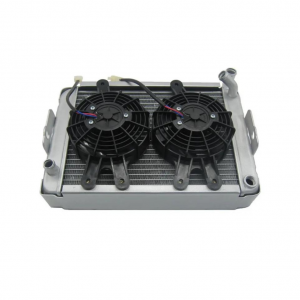The internal combustion engine is the heart of any motorcycle, providing the power and thrust needed to propel the machine at high speeds. However, as with any engine, heat is a by-product of the combustion process and failure to dissipate this heat can have serious consequences for engine performance and life. To prevent overheating and ensure efficient operation, every motorcycle is equipped with a cooling system, and at the heart of this system is the motorcycle engine radiator.

A motorcycle engine radiator is essentially a specialized heat exchanger designed to transfer heat from the engine to the outside air. It usually consists of a series of tubes or channels through which a cooling fluid (usually water, but sometimes a glycol-based mixture) is circulated, with fins or other cooling surfaces attached to the tubes to maximize heat transfer. transfer. Radiators are mounted either at the front of the machine or behind the engine to take advantage of the airflow created by the movement of the motorcycle.
Aluminum is one of the most commonly used materials in motorcycle engine radiator construction due to its high thermal conductivity, light weight and corrosion resistance. Aluminum motorcycle radiators can be found on a variety of bikes, from sporty superbikes to rugged adventure machines, and are often the upgrade of choice for riders looking for better cooling performance or less weight. However, other materials such as copper or brass can also be used, although these are less common in modern machines.
A motorcycle's cooling system typically consists of several components other than the radiator itself. These may include a water pump (or, in the case of some air-cooled engines, an oil cooler), hoses or pipes to circulate the coolant, a thermostat to regulate the temperature of the engine, and to increase heat dissipation during low temperatures Airflow fan - speed operation. Proper maintenance of the cooling system is critical to the health of the engine as neglecting things like flushing or changing the coolant can cause the radiator tubes to corrode or become clogged.
When choosing a motorcycle engine radiator or upgrading an existing one, there are several factors to consider. In addition to material, size and shape are also important, as they affect the radiator's ability to fit within the space available on the bike and dissipate the necessary heat. Some models may also offer additional features, such as a built-in oil cooler or adjustable fan controls, and can provide additional benefits depending on the needs of the rider.
In summary, a motorcycle engine radiator is an essential part of any bike's cooling system, responsible for dissipating the heat generated by the engine and keeping it running at an optimum temperature. Aluminum motorcycle radiators are a popular choice due to their light weight and high efficiency, but other materials and designs may also be suitable for some applications. Riders should be aware of the importance of proper maintenance and selection when it comes to this vital part of motorcycle performance.
Post time: Apr-20-2023



